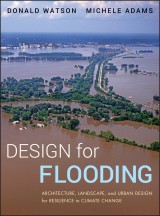Details

Design for Flooding
Architecture, Landscape, and Urban Design for Resilience to Climate Change1. Aufl.
|
87,99 € |
|
| Verlag: | Wiley |
| Format: | |
| Veröffentl.: | 19.10.2010 |
| ISBN/EAN: | 9780470890004 |
| Sprache: | englisch |
| Anzahl Seiten: | 320 |
DRM-geschütztes eBook, Sie benötigen z.B. Adobe Digital Editions und eine Adobe ID zum Lesen.
Beschreibungen
<p>“<i>Design for Flooding</i> contains considerable useful information for practitioners and students. Watson and Adams fill the void for new thinking…and they advance our ability to create more sustainable, regenerative, and resilient places.” <b>—Landscape Architecture Magazine</b></p>
<p>Preface and Acknowledgments vii</p> <p>Foreword by Carol Franklin, RLA, FASLA ix</p> <p>Foreword by Daniel E. Williams, FAIA xi</p> <p>Introduction xv</p> <p><b>Part I: Nature of Water 1</b></p> <p><b>Chapter 1: Weather 3</b></p> <p>1.1 Sun and Earth 3</p> <p>1.2 The Atmosphere 6</p> <p>1.3 Weather 17</p> <p><b>Chapter 2: Land and Water 31</b></p> <p>2.1 Water and Carbon Cycles 31</p> <p>2.2 Biodiversity and the Landscape 36</p> <p>2.3 Follow the Water: The Opportunity for Watershed Planning 43</p> <p><b>Chapter 3: Flooding 49</b></p> <p>3.1 Flooding from Increased Precipitation 49</p> <p>3.2 Flooding from Severe Storms 54</p> <p>3.3 Economic and Social Costs of Water-Related Natural Disasters 61</p> <p><b>Part II: Design With Water 67</b></p> <p><b>Chapter 4: The Natural Landscape 71</b></p> <p>4.1 Understanding the Natural Water Balance 71</p> <p>4.2 When the Water Balance Is Altered 74</p> <p>4.3 Soils and Vegetation 78</p> <p>4.4 Subsurface Water Movement 83</p> <p>4.5 Stream Systems, Wetlands, Riparian Zones, and Floodplains 84</p> <p><b>Chapter 5: The Altered Landscape 91</b></p> <p>5.1 When the Landscape Is Altered 91</p> <p>5.2 Altered Stream Systems and Increased Flood Damage 95</p> <p>5.3 Why Detention Does Not Solve Flooding 98</p> <p>5.4 Summary: The Natural Landscape as a Model for Resilient Design 99</p> <p><b>Chapter 6: Design for Inland Flooding 103</b></p> <p>6.1 Resilient Design for Inland Flooding 103</p> <p>6.2 Tools for Watershed Protection 125</p> <p>6.3 Communities and Buildings in Floodplains 129</p> <p><b>Part III: Flood-Resistant Design 131</b></p> <p><b>Chapter 7: Flood Design Analysis 135</b></p> <p>7.1 Definition of Terms 135</p> <p>7.2 Flood Elevation: Base Flood and Design Flood 143</p> <p><b>Chapter 8: The Coast 151</b></p> <p>8.1 Coastal Processes 151</p> <p>8.2 Shoreline Protection 160</p> <p>8.3 Flood Barriers and Floodgates 164</p> <p>8.4 Summary of Coastal Protection Measures 164</p> <p><b>Chapter 9: Flood Design Practices for Buildings 169</b></p> <p>9.1 Overview of Flood Design 169</p> <p>9.2 Flood Design at the Building Scale 176</p> <p><b>Part IV: Design For Resilience 197</b></p> <p><b>Chapter 10: Flood-Resistant Design for Sites and Communities 199</b></p> <p>10.1 Coastal Communities 199</p> <p>10.2 Comprehensive Planning for Resilient Communities 207</p> <p>10.3 Local Actions to Build Community Resilience 210</p> <p><b>Chapter 11: Sea Level Rise 219</b></p> <p>11.1 Sea Level Rise: The Issues 220</p> <p>11.2 Sea Level Rise: Design Responses 223</p> <p><b>Chapter 12: Design for Resilience 257</b></p> <p>12.1 The Wave of the Future 257</p> <p>12.2 Models for National and International Action 259</p> <p>12.3 Design Resolution 268</p> <p>Epilogue 271</p> <p>Glossary 273</p> <p>Index 295</p>
<p><b>DONALD WATSON<small>, FAIA,</small></b> an architect and planner, is former chair of the Yale School of Architecture Environmental Design Program, and former professor and dean of the School of Architecture, Rensselaer Polytechnic Institute. He received the 2002 ACSA Distinguished Professor Award and the 2005 AARC Haecker Leadership Award for Architectural Research. His publications include <i>Climatic Building Design</i>, winner in the Architecture and Urban Planning category of the American Publishers Award for Professional and Scholarly Excellence. <p><b>MICHELE ADAMS, P.E.,</b> a water resources engineer, is principal and founder of Meliora Environmental Design in Kimberton, Pennsylvania. Her work encompasses environ- mentally sensitive site design and sustainable water resources engineering.
<p>THE COMPLETE GUIDE TO <b>PLANNING AND DESIGN FOR WATER SUSTAINABILITY, AS WELL AS FLOODING AND NATURAL DISASTERS</b> <p>Architects, urban planners, and urban designers, as well as water resources engineers and landscape architects will discover that <i>Design for Flooding</i> presents the best practices and lessons to create buildings and communities that are more resilient in the face of severe weather, climate change, and the prospect of rising sea level. <p><i>Design for Flooding</i> covers technical and institutional issues—along with new design and business opportunities—built upon: <ul> <li>Fundamentals of climate and weather, stormwater and floodplain management</li> <li>Best practices of flood-resistant design and adaption to sea level rise</li> <li>Multidisciplinary design that integrates sound ecological and engineering principles</li> <li>Innovative design and construction to protect and improve water security</li> </ul> <p><b>"</b><b><i>Design for Flooding</i></b><b> defines the need and opportunity for planners, architects, landscape architects, engineers, and conservation biologists to work together to develop the mix of inland and coastal flooding solutions required for a comprehensive response to climate change."</b></br> —From the Foreword by Daniel Williams, FAIA, author of <i>Sustainable Design: Ecology, Architecture, and Planning</i> <p><b>"</b><b><i>Design for Flooding</i></b><b> should be a major tool for the design professions, for public agencies, and for civic activists, indeed for everyone who wishes to bring a genuinely 'intelligent' design for water to their communities. It is a call to action and demonstrates that we have the knowledge, the tools, and the capability to better manage the water system on which we depend."</b></br> —From the Foreword by Carol Franklin, FASLA <p>A portfolio of award-winning designs illustrates practical and visionary projects to prepare for a resilient future, including: <ul> <li>A case study of Climate's Long-term Impacts on Metro Boston (CLIMB) analyzes four alternatives to prepare for climate change</li> <li>A design charrette sponsored by The Regional Plan Association of New York illustrates creative concepts for waterfront revitalization and flood protection</li> <li>Lessons from the Netherlands, Japan, and the United States indicate the effectiveness of long-term preparedness planning combined with phased mitigation and renewal projects</li> <li>Examples include renovations and small buildings, showing how every project at any scale is a design opportunity to increase the sustainability and resilience of our communities, water, and ecosystem services</li> </ul> <p>COVER: 1993 Flood, West Alton, Missouri, near the confluence of Mississippi and Missouri Rivers. © 1993 Srenco Photography.
















